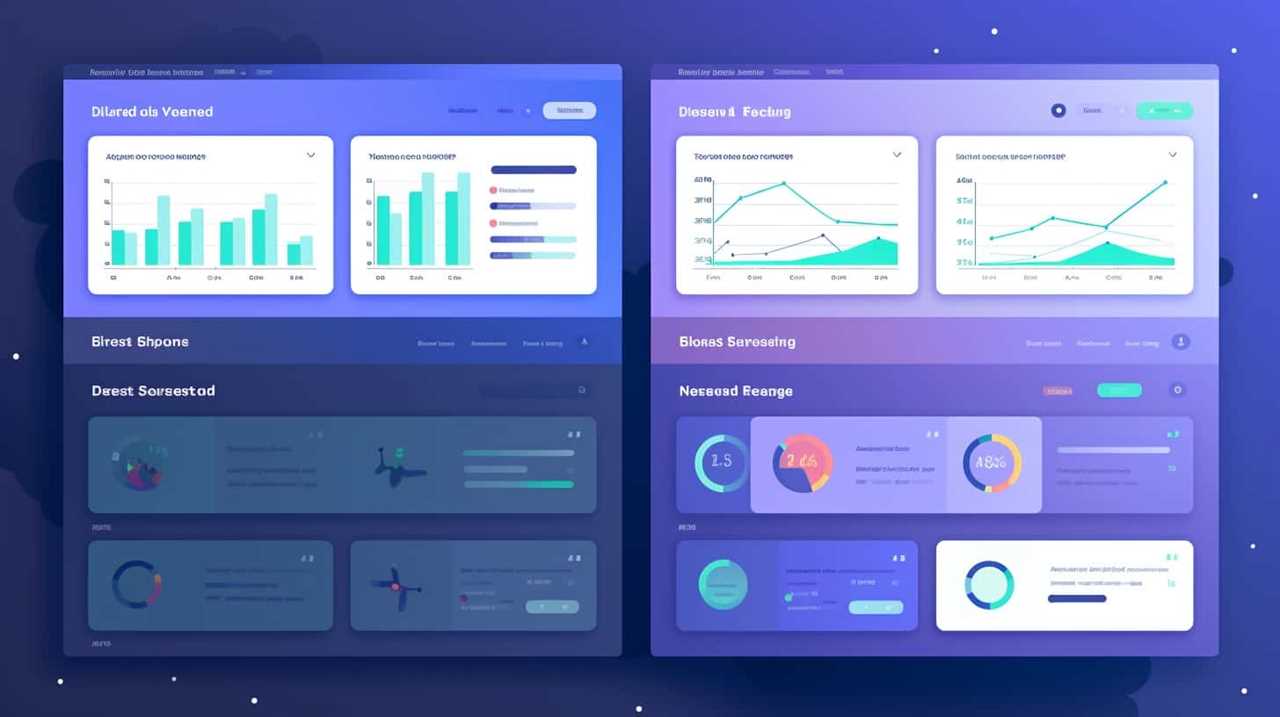Aiming to master the art of selecting SEO keywords? Prepare yourself, as we’ve crafted the definitive guide tailored specifically for you.
We’ll delve into the importance of keyword research, understanding those sneaky search engine algorithms, and identifying high-volume keywords.
But that’s not all. We’ll also break down the differences between long-tail and short-tail keywords, analyze keyword competition, and show you how to adapt for local SEO.
No more keyword stuffing or over-optimization.

Stay tuned and become a keyword selection guru!
Key Takeaways
- Thorough keyword research is crucial for optimizing website SEO performance.
- Incorporating long-tail keywords attracts highly relevant traffic and increases conversion chances.
- Understanding search engine algorithms is crucial for search engine optimization.
- Conducting competitor analysis helps identify gaps and opportunities in the market.
The Importance of Keyword Research
In this article, we’ll explore the significance of keyword research in optimizing our website’s SEO performance.
Keyword research plays a crucial role in ensuring that our website ranks high on search engine result pages (SERPs), driving organic traffic and increasing visibility.
One important aspect of keyword research is understanding the importance of long tail keywords. These are longer and more specific keyword phrases that target a narrower audience, but often have higher conversion rates. By incorporating long tail keywords into our content, we can attract highly relevant traffic and increase the chances of conversion.

Additionally, keyword research also impacts our PPC (Pay-Per-Click) campaigns. By identifying the most relevant and high-performing keywords, we can optimize our ad campaigns, increase click-through rates, and maximize our return on investment (ROI).
Therefore, conducting thorough keyword research is essential for both organic and paid search strategies.
Understanding Search Engine Algorithms
When it comes to search engine optimization, understanding search engine algorithms is crucial. Algorithm updates can have a significant impact on search rankings, so staying informed about these updates is essential.
Additionally, focusing on keyword relevance is key to optimizing content and improving search visibility. By understanding search engine algorithms and implementing strategies to align with them, we can enhance our SEO efforts and drive more organic traffic to our websites.

Algorithm Updates Impact Rankings
How do algorithm updates impact our rankings and how can we understand search engine algorithms?
Algorithm updates have a significant impact on our rankings, as they determine how search engines evaluate and rank websites. Understanding these algorithms is crucial for SEO success. Here are three key points to consider:
- Impact of algorithm updates on user experience: Search engines aim to provide the best possible user experience by delivering relevant and high-quality content. Algorithm updates are designed to improve user experience by penalizing sites with low-quality content, spam, or other unethical practices.
- The role of user intent in keyword selection: Search engines have become more sophisticated in understanding user intent. It’s essential to align our keyword selection with the user’s intent to improve rankings. By understanding what users are searching for and providing valuable content, we can optimize our website for improved visibility.
- Staying updated with algorithm changes: Search engine algorithms are constantly evolving. It’s crucial to stay up to date with algorithm changes and adapt our SEO strategies accordingly. By monitoring industry news, participating in SEO communities, and analyzing data, we can stay ahead of the curve and maintain strong rankings.
Importance of Keyword Relevance
Understanding keyword relevance is crucial for mastering SEO and optimizing website rankings according to search engine algorithms.
It isn’t enough to simply include keywords in your content; they must be relevant to the topic and context of your website.

Search engines use complex algorithms to determine the relevance of keywords and rank websites accordingly.
Two important factors to consider when optimizing keyword relevance are keyword density and keyword placement.
Keyword density refers to the frequency of keywords in your content, while keyword placement refers to where the keywords are positioned within your content.
By understanding these factors and aligning your keywords with the intent of your target audience, you can improve your website’s visibility and attract more organic traffic.

In the next section, we’ll discuss strategies to optimize content and further enhance keyword relevance.
Strategies to Optimize Content
To optimize content and understand search engine algorithms, we must employ effective strategies that align with the intent of our target audience. By implementing the right techniques, we can improve content visibility and increase organic traffic. Here are three strategies that can help us achieve these goals:
- Keyword Research: Conduct thorough keyword research to identify relevant and high-performing keywords that resonate with our audience. This will ensure that our content ranks well in search engine results pages (SERPs).
- On-Page Optimization: Optimize the structure and formatting of our content, including title tags, meta descriptions, headers, and URLs. Incorporate targeted keywords naturally throughout the content to enhance visibility.
- Content Creation: Develop high-quality, informative, and engaging content that meets the needs of our audience. By providing valuable information and addressing their pain points, we can attract more organic traffic and improve our visibility in search results.
Identifying High-Volume Keywords
We prioritize identifying high-volume keywords to maximize our SEO strategy’s impact. Conducting thorough high volume keyword research and effective keyword analysis is crucial for driving organic traffic to our website. By targeting keywords that have a high search volume, we can increase our chances of ranking higher in search engine results pages (SERPs) and reaching a larger audience. To help you understand the importance of identifying high-volume keywords, take a look at the table below:
| Keyword | Search Volume |
|---|---|
| SEO | 100,000 |
| Content | 80,000 |
| Marketing | 75,000 |
| Keywords | 60,000 |
| Optimization | 55,000 |
As you can see, these keywords have high search volumes, indicating a large number of people are searching for them. This presents a valuable opportunity for us to optimize our content and attract more organic traffic. Now, let’s delve into the next section, where we will compare long-tail and short-tail keywords to determine the best approach for our SEO strategy.

Long-Tail Vs. Short-Tail Keywords
When comparing long-tail and short-tail keywords, it’s important to consider their impact on our SEO strategy. Here are three key factors to keep in mind:
- Search Volume: Short-tail keywords typically have higher search volume, attracting a larger audience. On the other hand, long-tail keywords have lower search volume but are more specific, targeting a niche audience.
- Competition: Short-tail keywords are highly competitive, making it challenging to rank higher in search results. Long-tail keywords, however, face less competition, giving us a better chance of ranking well.
- Intent: Short-tail keywords are often used by users in the awareness or consideration stage, while long-tail keywords indicate a user’s specific intent, making them more valuable for conversion-focused strategies.
Considering the rise of voice search, it’s crucial to prioritize long-tail keywords as they align with the conversational nature of voice queries. By selecting the right mix of long-tail and short-tail keywords, we can optimize our SEO strategy for both search and voice.
Analyzing Keyword Competition
When it comes to analyzing keyword competition, there are several key points to consider.
First, evaluating keyword difficulty allows us to assess how challenging it will be to rank for a particular keyword.

Second, competitor analysis techniques help us understand what strategies our competitors are using and how we can differentiate ourselves.
Lastly, choosing low-competition keywords can give us an advantage in the search results and increase our chances of ranking higher.
Evaluating Keyword Difficulty
To accurately assess keyword difficulty, it’s essential to employ a reliable and comprehensive evaluation method. When evaluating keyword competition and analyzing keyword difficulty, there are several key factors to consider:
- Search Volume: Look for keywords with a high search volume, as this indicates a higher level of competition.
- Relevancy: Assess how closely the keyword aligns with your content and target audience. A highly relevant keyword is likely to have more competition.
- Backlink Profile: Analyze the backlink profiles of top-ranking pages for the keyword. A high number of quality backlinks can indicate a more competitive keyword.
By carefully considering these factors, you can gain valuable insights into keyword difficulty and make informed decisions about your SEO strategy.

Competitor Analysis Techniques
Our approach to competitor analysis techniques for analyzing keyword competition involves a thorough examination of the existing landscape. By evaluating the strategies and tactics employed by our competitors, we gain valuable insights into their keyword selection and optimization techniques. This allows us to identify opportunities and gaps in the market that we can leverage for our own SEO efforts.
To effectively analyze keyword competition, we utilize a combination of qualitative and quantitative methods. This includes examining competitor websites, analyzing their on-page optimization, and conducting backlink analysis. By understanding the keywords they are targeting, the content they are creating, and the websites that are linking to them, we can develop effective keyword research strategies that set us apart from the competition.
In order to visualize this process, let’s take a look at a table showcasing the competitor analysis techniques we employ:
| Competitor Analysis Techniques | Description | Benefits |
|---|---|---|
| Examining competitor websites | Analyzing the structure, content, and layout of competitor websites to identify their targeted keywords and optimization strategies. | Reveals potential keyword opportunities and highlights areas for improvement. |
| On-page optimization analysis | Evaluating how competitors optimize their content, including title tags, meta descriptions, and headers, to determine their keyword targeting strategies. | Provides insights into effective optimization techniques and helps identify gaps in competitor strategies. |
| Backlink analysis | Investigating the websites that are linking to our competitors to uncover potential link building opportunities and assess the quality of their backlink profiles. | Identifies valuable linking opportunities and allows for strategic link building efforts. |
Choosing Low-Competition Keywords
To effectively analyze keyword competition and choose low-competition keywords, we employ a comprehensive approach that involves evaluating the existing landscape and leveraging competitor analysis techniques. This strategic process allows us to find niche keywords that have less competition, providing us with a greater opportunity to rank higher in search engine results.

Here are three essential steps we take in our keyword selection process:
- Identify Long Tail Keywords: Long tail keywords are longer and more specific phrases that target a narrower audience. They often have lower competition and higher conversion rates, making them valuable for SEO.
- Analyze Competitor Keywords: By analyzing the keywords your competitors are targeting, you can gain insights into their strategies and identify areas of opportunity where you can differentiate yourself.
- Evaluate Keyword Difficulty: Using keyword research tools, we assess the difficulty level of each keyword by analyzing factors such as search volume, competition, and domain authority. This helps us prioritize low-competition keywords that are more achievable to rank for.
Tools for Effective Keyword Research
We frequently rely on various tools to conduct effective keyword research. When it comes to finding the right keywords for our SEO strategy, it’s essential to use the best tools available.
One such tool is Google’s Keyword Planner, which provides valuable insights and suggestions based on search volume and competition.
Another effective tool is SEMrush, which offers comprehensive keyword analysis and competitor research.

Additionally, Moz’s Keyword Explorer provides in-depth data on keyword difficulty and organic click-through rate.
These tools allow us to identify high-value keywords and uncover opportunities for optimization.
To ensure our keyword research is successful, it’s important to follow best practices such as targeting long-tail keywords, considering user intent, and analyzing competitor keywords.
Creating a Keyword Strategy
Developing a solid keyword strategy involves conducting thorough research and analysis to identify the most relevant and high-performing keywords for our SEO campaign.

To effectively create a keyword strategy, we need to consider the following:
- Understanding our target audience: By knowing our audience’s preferences, needs, and search patterns, we can choose keywords that resonate with them.
- Competitor analysis: Analyzing our competitors’ keyword selection strategies can provide valuable insights and help us find opportunities for differentiation.
- Long-tail keywords: Focusing on long-tail keywords can help us target specific niches and attract highly motivated and qualified traffic.
To develop an effective keyword strategy, we must combine these keyword analysis techniques with a deep understanding of our business goals and objectives.
Incorporating Keywords Into Website Content
First, let’s delve into how we can effectively incorporate keywords into our website content to optimize our SEO strategy. When incorporating keywords naturally, it’s important to strike a balance between keyword optimization and providing valuable content for our audience. To achieve this, we can follow a strategic approach.
One method is to identify primary and secondary keywords based on relevance and search volume. These keywords can then be incorporated into our content strategically, without compromising readability. Another aspect to consider is optimizing keyword density. While there is no fixed rule for keyword density, a general guideline is to aim for around 1-2% keyword usage in our content.

To help visualize this approach, here’s a table showcasing an example of incorporating keywords into website content:
| Content Section | Keywords |
|---|---|
| Homepage | SEO, keyword selection |
| Blog Post | keyword strategy, SEO tips |
| About Us Page | website optimization, keyword research |
| Product Descriptions | keyword usage, SEO best practices |
Optimizing Meta Tags and Descriptions
To further enhance our SEO strategy, let’s now explore the crucial aspect of optimizing meta tags and descriptions to improve our website’s visibility.
Here are three key strategies for optimizing title tags and headers:
- Use targeted keywords: Incorporate relevant keywords in your title tags and headers to improve search engine rankings and attract the right audience.
- Keep it concise and clear: Write concise and descriptive title tags and headers that accurately represent the content of your web pages.
- Structure for readability: Use header tags (H1, H2, etc.) to organize your content and make it more user-friendly and scannable.
Improving meta tag readability is also essential for SEO success. Consider the following tips:

- Use compelling descriptions: Craft enticing meta descriptions that accurately summarize your page content and entice users to click through.
- Optimize length: Keep your meta descriptions within the recommended character limit to ensure they’re fully displayed in search results.
- Avoid duplicate meta tags: Each page should have a unique meta tag to avoid confusion and improve search engine visibility.
Utilizing Keywords in URLs and Anchor Text
In our SEO strategy, we extensively utilize targeted keywords in both URLs and anchor text to optimize our website’s visibility and attract the right audience. Using keywords in anchor text for internal linking is a vital tactic that helps search engines understand the context and relevance of our content.
By incorporating relevant keywords into anchor text, we enhance the user experience and increase the chances of ranking higher in search engine results. Additionally, utilizing keywords in URLs plays a significant role in better search engine optimization. Including keywords in URLs helps search engines identify the content of the page, making it easier for them to crawl and index our website.
This optimization tactic further improves our website’s visibility and organic traffic. Now that we understand the importance of using keywords in URLs and anchor text, let’s move on to the next section about monitoring keyword performance.
Monitoring Keyword Performance
One important aspect of our SEO strategy is monitoring the performance of our chosen keywords. To ensure the effectiveness of our keyword selection, we regularly track and analyze their performance. Here are three key reasons why monitoring keyword performance is crucial for SEO success:

- Evaluating keyword ranking: By tracking keyword rankings, we can determine how well our chosen keywords are performing in search engine results pages (SERPs). This allows us to identify opportunities for improvement and make necessary adjustments to our SEO strategy.
- Identifying trends and patterns: Keyword tracking enables us to identify trends and patterns in search behavior. This information helps us stay ahead of the curve and optimize our content to align with the evolving needs and preferences of our target audience.
- Measuring keyword effectiveness: Monitoring keyword performance allows us to measure the effectiveness of our keywords in driving organic traffic, conversions, and engagement. This data helps us prioritize and focus our efforts on keywords that deliver the best results.
Adapting Keyword Selection for Local SEO
When it comes to local SEO, conducting thorough local keyword research is essential. By targeting specific locations in your keyword selection, you can optimize your content to better align with the needs and preferences of your local audience.
Additionally, optimizing for local intent, such as including location-specific keywords and creating location-based landing pages, can help improve your website’s visibility and attract more relevant local traffic.
Local Keyword Research
We extensively research local keywords to adapt our keyword selection for local SEO. When targeting local customers, effective local keyword research is crucial for optimizing website content and driving targeted traffic to our business.
Here are three key strategies we employ in our local keyword research:

- Analyzing local search trends: We stay updated with the latest trends in our target location, identifying popular search terms and incorporating them into our keyword selection.
- Utilizing location-specific modifiers: By adding location-specific terms, such as city names or neighborhood names, to our keywords, we improve our chances of appearing in local search results.
- Conducting competitor analysis: We analyze the keywords that our local competitors are targeting, identifying gaps and opportunities to help us refine our own keyword selection.
Targeting Specific Locations
To effectively adapt our keyword selection for local SEO, it is essential to target specific locations by incorporating location-specific modifiers into our keywords. By doing so, we can optimize for local search and attract the right audience to our website. When targeting specific locations, it’s important to consider the demographics of that area and tailor our keyword selection accordingly. For example, if we are targeting a city with a large student population, we might include keywords related to student discounts or affordable options. On the other hand, if we are targeting a suburban area with families, we might focus on keywords that highlight family-friendly amenities or services. By understanding the specific needs and preferences of our target audience, we can create a more effective keyword strategy that maximizes our visibility and relevance in local search results.
| Target Location | Target Demographics |
|---|---|
| City | Students |
| Suburban Area | Families |
| Rural Town | Outdoor Enthusiasts |
| Tourist Hotspot | Travelers |
Optimizing for Local Intent
To optimize for local intent and adapt our keyword selection for local SEO, we can incorporate location-specific modifiers to target specific locations and attract the right audience to our website. By implementing this strategy, we can improve our local search rankings and increase our visibility to potential customers in our target areas.
Here are three key techniques for optimizing local intent:
- Include location-specific keywords: Incorporate the name of the city or region in your keyword selection to ensure that your website appears in local search results.
- Create location-specific landing pages: Develop dedicated landing pages for each target location, providing relevant information and optimizing content with location-specific keywords.
- Optimize Google My Business listing: Claim and optimize your Google My Business profile by adding accurate location information, business hours, photos, and customer reviews.
Avoiding Keyword Stuffing and Over-Optimization
When avoiding keyword stuffing and over-optimization in SEO, it’s important to strike a balance between keyword usage and maintaining a natural flow of content.

Keyword stuffing, which refers to the excessive use of keywords in an attempt to manipulate search engine rankings, can result in penalties from search engines and a poor user experience.
On the other hand, under-optimization can lead to missed opportunities for visibility and organic traffic.
To avoid keyword stuffing, it’s crucial to focus on creating high-quality, valuable content that meets the needs of your target audience. This includes conducting thorough keyword research to identify relevant and targeted keywords, and incorporating them strategically throughout your content while maintaining keyword density at a reasonable level.
Staying Updated With SEO Keyword Trends
We stay updated with SEO keyword trends by continuously monitoring industry changes and analyzing user search behavior. Staying on top of search engine updates is crucial in order to maintain a competitive edge.

Here are three strategies we employ to ensure we’re incorporating trending keywords effectively:
- Conducting regular keyword research: We use various tools to identify new keywords that are gaining popularity. This helps us stay ahead of the curve and adapt our content accordingly.
- Analyzing user search behavior: By examining search data and trends, we gain insights into what users are looking for. This allows us to align our content with their needs and optimize for relevant keywords.
- Monitoring industry changes: SEO is a dynamic field, and search engine algorithms are constantly evolving. We stay informed about the latest updates and trends to ensure our keyword strategies remain effective.
Frequently Asked Questions
How Do I Choose the Right Keywords for My Specific Industry or Niche?
When choosing keywords for our specific industry or niche, we rely on the best keyword research tools to identify industry-specific keywords. Additionally, analyzing our competitors’ keyword choices informs our own selection process.
What Are Some Effective Strategies for Finding Long-Tail Keywords With Low Competition?
To find long-tail keywords with low competition, we employ effective strategies. By optimizing for voice search and considering the impact of mobile search on targeting, we can uncover valuable opportunities for our specific industry or niche.
How Can I Track the Performance of My Chosen Keywords Over Time?
We track the performance of our chosen keywords over time by analyzing keyword performance metrics. It is essential to monitor and track keyword rankings to understand their effectiveness in driving organic traffic and optimizing our SEO strategy.

Are There Any Specific Strategies for Incorporating Keywords Into My Website Content Without Appearing Spammy or Over-Optimized?
When it comes to incorporating keywords into website content, we must be strategic. By following best practices and optimizing without appearing spammy or over-optimized, we can naturally enhance our website’s visibility and attract targeted traffic.
What Are Some Common Mistakes to Avoid When Selecting and Using Keywords for Local Seo?
When selecting and using keywords for local SEO, it’s crucial to avoid common mistakes. By understanding how to optimize keywords for local SEO, we can ensure our strategies are effective and our website stands out.
Conclusion
In conclusion, mastering SEO keyword selection is crucial for driving organic traffic and improving search engine rankings. By understanding search engine algorithms, identifying high-volume keywords, and analyzing keyword competition, we can strategically optimize our content to attract the right audience.
It’s like navigating through a dense forest with a compass, carefully selecting the most effective path to reach our destination. By staying updated with SEO keyword trends and avoiding keyword stuffing, we can ensure our content remains relevant and valuable in the ever-evolving digital landscape.










